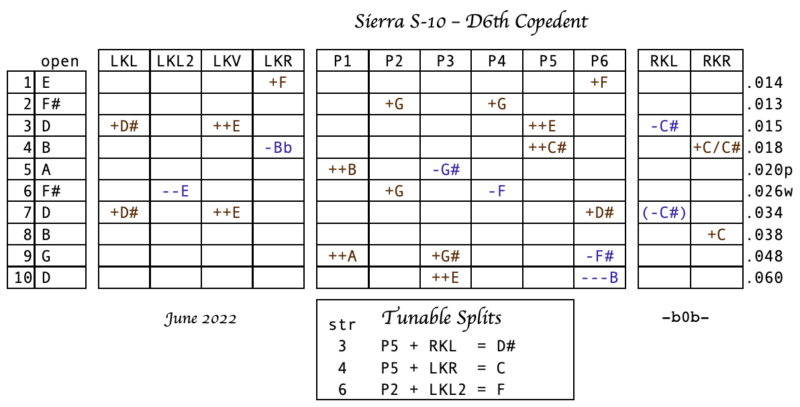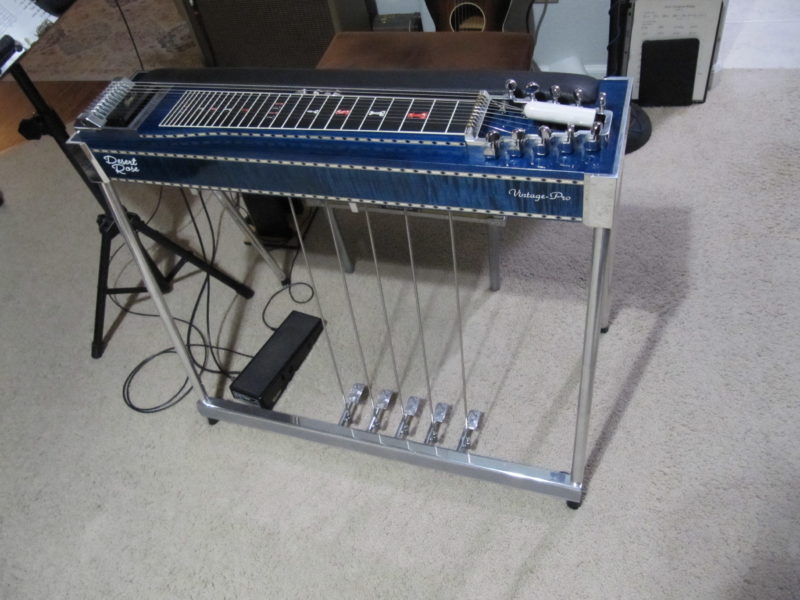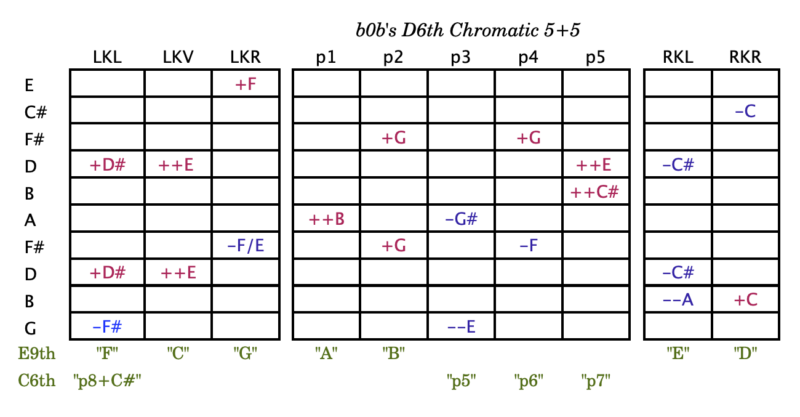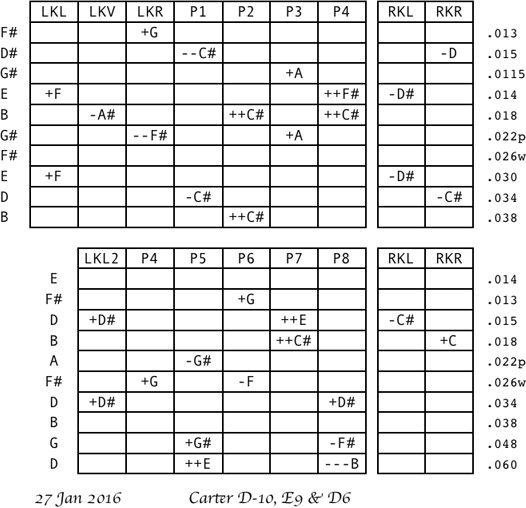2017 Sierra prototype by Ross Shafer, S-10 Hybrid D6th
In a quest for a single neck copedent that could handle almost anything, I’ve settled on this 10-string with 6 pedals and 6 knee levers. D is midway between C and E, so D6th is midway between E9th and C6th. The string order is like C6th, but all of the high intervals of the E9th are still there. The trick is that notes from the E9th string 2 are on string 4 instead.

P1 and P2 are the E9th A+B changes. LKL and RKL are like raising and lowering the E’s on E9th. RKR provides the “chromatic” notes of the E9th 2nd string, which are now on the 4th string. Pedal 5 has the bounce of the E9th “C pedal” on the 3rd string, while LKV provides a more “squeezable” raise. LKL2 lowers the 6th string a full step like a lot of modern E9th players do. The main things missing from the E9th are the 7th and 10th strings, because they would get in the way of standard C6th-style playing.
Everything from the standard C6th is there (raised a step to D6th) on P3, P4, P5, P6, LKL, LKR, RKL and RKR. The 7th string RKL change in parenthesis is rodded for country/folk/rock (E9th 8th string lower). The tuning nut gets backed out when the music is more oriented towards swing/standards/jazz and extended chords.
Desert Rose S-10 D6th Chromatic

In a variation of the Hybrid D6th concept, this Desert Rose Vintage Pro’s copedent doesn’t include the low 10th string root of the C6th. Instead, it inserts the E9th’s 2nd string, tuned to the major 7th of the scale. I call the copedent “D6th Chromatic”.

Most of the common E9th and C6th changes are present, rooted in D instead of E or C. Having 7 strings of ringing scale notes in the top octave gives the tuning a harp-like quality. Major, minor, and 7th chords are “strummable” on the low strings, adding the ability to play rhythm when another instrument takes the lead.
This Desert Rose pedal steel has a beautiful country sound. It has a George L’s EON pickup, Tom Bradshaw’s MSA replacement fretboard, and Russler foot pedals. It was built by Chuck Back for my dear friend Johnnie Robbins, who has since passed away. I play it for Johnnie. ✞
Carter D-10 (sold)
I previously used a Carter D-10 for teaching. This instrument was built with 8 pedals and 5 knee levers (I added the LKL2). It was one of the last Carters produced. The beautiful sunburst body was finished by Mark Giles, and the guitar was built in Canada by Al Brisco. It has the 4 raise, 2 lower changer that was typical of late model Carters. I no longer own this guitar – the notes below the chart were written in 2016.
I didn’t use a half-stop knee lever – I lower the 2nd string D# to C# on the 1st pedal instead. This also allowed me to use it with the E lowers (RKL) for pentatonic blues riffs. To me, having the standard A B C pedals on P2, P3 and P4 is more comfortable ergonomically.
This guitar has tunable splits, which means that I could combine LKR and P3 to get a tunable G note on the middle G#, or combine LKV with P2 or P4 for a tunable C note on the middle B string. Tunable splits are a feature that you don’t find on older steel guitars.
The back neck is tuned to D6th, a step higher than the standard C6th, to match my Sierra S-10. The standard back neck P4 changes are missing – the pedal would have been too stiff with the addition of the E9th changes. Instead, I added a single half-step raise in the middle F#. This gave me the open strings of the Dobro G tuning for bluegrass hammer-ons and pull-offs.
-b0b-

